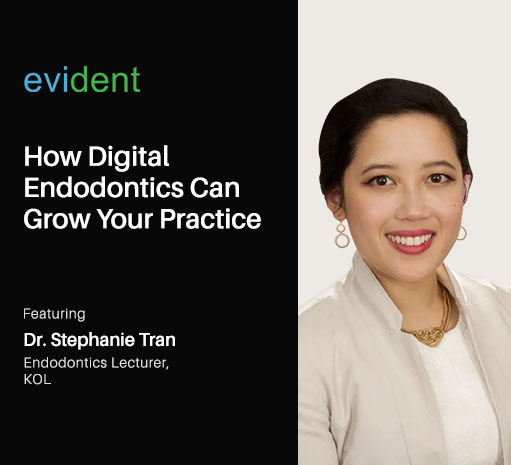

Just like how digital dentistry has taken over restorative dentistry, endodontics is seeing its own share of technological innovations too.
A traditional endodontic procedure may involve drilling into the tooth to diagnose the pulp. With digital endodontics, practitioners are given more advanced tools that allow them to assess the pulp without drilling into the tooth.
This is only one of the various benefits of digital endodontics.
Evident held a webinar interview with Dr. Stephanie Tran, an experienced endodontist practicing in New York City and Long Island. Dr. Stephanie is also an avid lecturer, holding courses on endodontic treatments. In the interview, Dr. Stephanie discussed in-depth the tools used in digital endodontics as well as the benefits of digital endodontics to both patients and clinicians.
Tools in Digital Endodontics
Similar to digital dentistry, digital endodontics gives endodontists a technological edge, allowing them to go about their procedures more efficiently and accurately. The new age of endodontic technology also gives patients a better chair experience and service quality.
Listed below are some of the tools used in digital endodontics:
Digital X-Rays
The traditional method of using film to capture X-ray images is highly dependent on the quality of the film and the processing techniques used. Developing film also requires the use of chemicals, such as sodium hydroxide and ammonium, to produce a clear, decipherable image.
Digital X-rays, on the other hand, utilize digital sensors to convert X-rays into an electronic signal that is processed by a computer. This data is then displayed on a screen. This eliminates the need for a film-developing stage, allowing the clinician and patient to see the image immediately.
Digital X-ray images are also stored electronically, as opposed to taking up file cabinet space. In addition, they offer better image quality and require less X-ray radiation to produce an image.
Cone-beam CT scanner
On the topic of digital X-ray technology, one useful marvel is CBCT scanning (Cone-beam CT scanning). CBCT scanning provides a three-dimensional view of the patient’s anatomy, particularly the oral and facial structures.
Unlike traditional medical CT scanners, which use a fan-shaped X-ray beam, CBCT scanners use a cone-shaped X-ray beam. This cone-shaped beam rotates around the patient, capturing a series of X-ray images from different angles. The captured images are then reconstructed by computer software to create a detailed 3D representation of the scanned area.
This gives clinicians a more comprehensive view of the tooth structure, allowing endodontics to assess problems that otherwise wouldn’t be possible without drilling into the tooth first (e.g., root canal treatment). As a result, endodontists already know the patient’s tooth structure inside and out before any surgical procedure is performed.
CBCT can also focus its scanning area on a smaller area, allowing it to use only the radiation it needs. This means less radiation is being blasted onto the patient, especially if only a single tooth or area needs to be assessed.
3D Designing and Printing
When partnered with CBCT scanning and 3D intraoral (IOS) scanning, dental technicians can design and 3D print surgical guides for endodontics. But surgical guides in endodontics are different from the ones used in restorative dentistry.
Dr. Stephanie mentioned the importance of surgical guides, particularly apical guides and access guides in endodontics.
Apical guides allow endodontists to determine immediately where the apicals of a tooth are.
So, instead of creating a huge flap in the tissue to find the apical region, endodontists may create a smaller, more precise flap since they’d already know where the apical region is due to the digital scans.
Another type of surgical guide that can be 3D printed is an access guide.
An access guide helps clinicians drill straight down into the root canal, eliminating the need to look for the canals mid-surgery. Access guides are designed from the CBCT scan; providing enough data for dental technicians to print an accurate guide that leads clinicians to the patient’s root canal.
However, in order to efficiently use these endodontic surgical guides, they must be properly-designed from the get-go.
Evident’s digital design services give endodontists the high-functioning components and cases they need, from temporary crowns to RPD frameworks. We can print detailed surgical guides as well. Simply provide us with the necessary CBCT and IOS scans, and we’ll return you with a ready-to-print model file within 24 hours.
Other Tools
There are endodontic advancements that are more material and technique innovations than they are digital ones.
Nonetheless, they help achieve the minimally-invasive workflow that digital endodontics (and digital dentistry in general) aims to provide. Dr. Stephanie mentions the following tools:
- Controlled Memory Nickel-Titanium Files. Controlled memory NiTi instruments are highly flexible due to their unique alloy composition. This flexibility allows them to follow the natural curves of the root canal without causing excessive stress or strain on the instrument or the tooth. Additionally, smaller file designs allow for less tooth structure to be removed.
- Bioceramics. Bioceramic materials are used as alternatives to traditional root canal filling materials, such as gutta-percha. Bioceramics are biocompatible, bioactive, and have antimicrobial properties, helping to disinfect the root canal system and prevent reinfection. They also exhibit excellent sealing ability, minimizing the chances of bacterial leakage and promoting the long-term success of the treatment. Dr. Stephanie mentions that bioceramics also help tissue regrow more effectively, and can be used to help remedy issues that weren’t before possible (e.g., regrowing a tooth pulp, fixing transportation, perforations)
Benefits of Digital Endodontics
Less Invasive
Digital endodontics is centered around creating a less-invasive procedure for the patient. This has a ton of benefits for the patient, such as improved recovery time and better quality of life.
CBCT scans, along with other 3D scans and digital X-ray images, allow clinicians to see the operative site before it’s even opened up. This technology gives surgeons the opportunity to plan their procedures and treatments in advance, minimizing errors and guesswork.
As a bonus, digital X-rays also utilize less radiation, which can be highly beneficial for the patient.
So, when a patient comes in to have a pulp diagnosed, clinicians won’t need to numb the patient up and drill a hole into the tooth. Clinicians simply have to perform a couple of scans, and they’ll have the data they need to go about the endodontic procedure.
Less Chair Time
As a result of this technology, patients spend less time in the chair.
Digital imaging (e.g., CBCT scans) and software tools in endodontics provide advanced visualization and analysis capabilities. This reduces the need for additional appointments or imaging procedures, such as multiple X-rays being taken.
This gives both patients and endodontists more time in the day to go about other tasks and activities. For endodontists, that means being able to see more patients in a business day. For patients, that may mean enjoying the rest of the day or having enough time to get to work.
More Cost Efficient
There are a number of benefits brought about by a digital workflow that play into reducing overhead and expenses for an endodontic business.
First, digital endodontics, as we’ve mentioned, reduces guesswork and errors. This minimizes the instances in which a patient would have to come back and get another treatment/procedure to repair a slip-up resulting from using traditional methods (e.g., transportation).
Another benefit is reduced resupply and overhead costs. Clinics won’t have to supply film-developing chemicals anymore for their X-ray procedures; endodontics won’t be using up as much anesthetic solutions since they don’t have to numb up a patient as often anymore; and a radiologist’s expertise won’t always be required to read imaging due to CBCT scans’ clarity and ability to narrow the scanning region onto a much smaller area.
Evident Digital supports endodontic practices of all sizes in their digital dentistry endeavors. Our comprehensive services, from design to CAD/CAM enablement and secure data storage, cater to your specific needs. Our expert team is dedicated to ensuring your success with tailored solutions. Join the future of endodontics with Evident Digital. Explore our offerings today.








